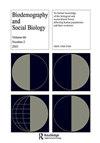Russia’s invasion of Ukraine and the future demographic crisis
IF 0.9
4区 社会学
Q3 DEMOGRAPHY
引用次数: 0
Abstract
Russia’s invasion of Ukraine on 24 February 2022 turned out to be the most significant military assault by one European nation on another since the Second World War. Due to this aggression, 3,821,049 refugees fled Ukraine in the first month since the invasion (UNHCR 2022a). The country has long suffered population decline since its independence in 1991. With ultra-low fertility rates and high death rates, Ukraine’s population decreased from its 1993 peak of 52,244,100 to 41,130,432 on February 1, 2022 – a 21.3 per cent drop. The Russian invasion is a demographic crisis that happened in the middle of a long-lasting larger demographic crisis. Through this invasion alone, Ukraine has lost an additional 7.3 per cent of its population in just the first month. The demographic crisis of the invasion is even murkier because population loss is highly concentrated in women and children. From day one of the invasion, men aged 18 to 60 were banned from leaving the country under martial law. A recent survey of 1,844 refugees conducted by the UNHCR shows that 88 per cent of respondents were women, and more than half traveled with children (UNHCR/REACH 2022). Although this survey was not necessarily population-representative, the UNHCR admitted that about ninety percent of all refugees are women and children in other interviews (UNHCR 2022b). Given 1.8 million or 24.1 per cent of all children who have crossed into neighboring countries as refugees, Ukraine has already lost an estimated 1.6 to 1.8 million, or 8.5 to 9.6 percent of, women aged 18 and older (UNICEF 2022). Some of these women (and children) will return to their homeland, but a recent study found that only about 30 per cent of refugees return to their country of origin (Constant, Culbertson, and Blake et al. 2021). If most of them do not return, this will create a significant gender and age imbalance in the Ukrainian population, especially in the current and future reproductive age group. The invasion also affects women who remain in Ukraine. It is known that males, whether soldiers or civilians, are more likely to be killed in direct warfare, but recent studies suggest that the overall excess mortality resulting from conflict is higher among women, mainly due to increased maternal mortality (Ghobarah, Huth, and Russett 2004; Plümper and Neumayer 2006; Urdal and Che 2013). It was already reported that more than 4,300 births have occurred in Ukraine during the invasion, and an estimated 80,000 women are expected to give birth in the next three months, many of whom will be without adequate access to maternal healthcare (even without the military attacking these healthcare facilities) (UNFPA/UNICEF/WHO, 2022). Additionally, 2.5 million children are internally displaced inside Ukraine and lack access to basic services and protection (UNICEF 2022). Coupled with the devastating economic and social situation, which also affects future fertility, it is almost sure that Europe’s largest humanitarian crisis will soon become an unprecedented demographic crisis in recent history. The number of refugees fleeing Ukraine and the death toll still growing means accurate numbers are not entirely known. Demographers and social scientists should closely review the direct demographic俄罗斯入侵乌克兰与未来的人口危机
2022年2月24日,俄罗斯入侵乌克兰,这是自第二次世界大战以来,一个欧洲国家对另一个国家最重大的军事袭击。由于这场侵略,3821049名难民在入侵后的第一个月逃离乌克兰(联合国难民署2022a)。自1991年独立以来,该国人口长期下降。由于超低的生育率和高死亡率,乌克兰人口从1993年的52244100人的峰值下降到2022年2月1日的41130432人,下降了21.3%。俄罗斯的入侵是一场人口危机,发生在一场旷日持久的更大的人口危机之中。仅通过这次入侵,乌克兰就在第一个月内又损失了7.3%的人口。入侵造成的人口危机更加模糊,因为人口流失高度集中在妇女和儿童身上。从入侵的第一天起,根据戒严令,18至60岁的男子被禁止出境。联合国难民署最近对1844名难民进行的一项调查显示,88%的受访者是妇女,超过一半的人带着孩子旅行(UNHCR/REACH 2022)。尽管这项调查不一定具有人口代表性,但联合国难民署在其他采访中承认,约90%的难民是妇女和儿童(联合国难民事务高级专员办事处2022b)。鉴于180万,即24.1%的儿童作为难民越境进入邻国,乌克兰已经失去了160万至180万,或8.5%至9.6%的18岁及以上妇女(联合国儿童基金会,2022年)。其中一些妇女(和儿童)将返回家园,但最近的一项研究发现,只有约30%的难民返回原籍国(Constant、Culbertson和Blake等人,2021)。如果他们中的大多数人不回来,这将在乌克兰人口中造成严重的性别和年龄失衡,尤其是在当前和未来的生育年龄组。入侵还影响到留在乌克兰的妇女。众所周知,男性,无论是士兵还是平民,都更有可能在直接战争中丧生,但最近的研究表明,冲突导致的总体超额死亡率在女性中更高,主要是由于孕产妇死亡率增加(Ghobarah、Huth和Russett,2004年;Plümper和Neumayer,2006年;Urdal和Che,2013年)。据报道,在入侵期间,乌克兰发生了4300多例分娩,预计未来三个月将有80000名妇女分娩,其中许多人将无法获得足够的孕产妇保健(即使没有军队袭击这些保健设施)(人口基金/儿基会/世界卫生组织,2022年)。此外,250万儿童在乌克兰境内流离失所,无法获得基本服务和保护(联合国儿童基金会,2022年)。再加上毁灭性的经济和社会形势,也影响了未来的生育率,几乎可以肯定的是,欧洲最大的人道主义危机将很快成为近代史上前所未有的人口危机。逃离乌克兰的难民人数和死亡人数仍在增长,这意味着准确的数字尚不完全清楚。人口学家和社会科学家应密切审查直接的人口统计
本文章由计算机程序翻译,如有差异,请以英文原文为准。
求助全文
约1分钟内获得全文
求助全文
来源期刊

Biodemography and Social Biology
Multiple-
CiteScore
1.50
自引率
0.00%
发文量
14
期刊介绍:
Biodemography and Social Biology is the official journal of The Society for the Study of Social Biology, devoted to furthering the discussion, advancement, and dissemination of knowledge about biological and sociocultural forces affecting the structure and composition of human populations. This interdisciplinary publication features contributions from scholars in the fields of sociology, demography, psychology, anthropology, biology, genetics, criminal justice, and others. Original manuscripts that further knowledge in the area of social biology are welcome, along with brief reports, review articles, and book reviews.
 求助内容:
求助内容: 应助结果提醒方式:
应助结果提醒方式:


